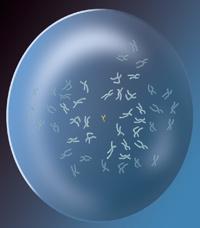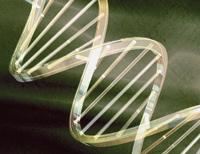Chromosome Y, key to being a man

Today, women cannot have children without man's hope, but perhaps in the future. Half of the genetic information needed for the development of the egg is missing, the information contained in sperm, but this problem can be solved. Starting from two eggs, all the information can be collected and the child will be born without the participation of the male.
It is not just fiction, but it was carried out in the mouse by Japanese biologists who published the result in April 2004. The born mouse was necessarily female, since the information to develop the male mouse only has the sperm.
The experiment had a great impact. It would extend to human beings who feared some men. “Is it possible that soon women do not need to have a child? Could a society be created without men?” Missing men will also lack sperm and, from a scientific point of view, a chromosome, the Y chromosome, will be lost. However, there is no reason for fear, almost certainly a society without men will not be created and, on the other hand, there are those who think that the chromosome Y will disappear by itself.
Difficult healing
The Y chromosome has a very special place in the genome, it is not like the rest. Only men have a copy, and it is also accompanied by a copy of the X chromosome. That's why they say men's sex chromosomes are X and Y (women are X and X). It is not a simple rarity, that means that in men there is no backup. The other chromosomes are duplicated and when errors occur the other is used to correct them. (This is what biochemists call recombination.) It's a good idea. There will almost always be a copy without errors. But the Y chromosome has no copy, so errors that occur cannot be repaired by recombination. There is nowhere to copy the information, so over time the Y chromosome accumulates errors.

This accumulation of errors was found in the human genome project by decoding the sequence of the Y chromosome. And not only that, most parts of the chromosome were filled with junk DNA, that is, parts that do not code proteins
So far not many genes have been found in the Y chromosome code, only 78 genes. On a chromosome 78 genes are not very large considering that we have about 30,000 separate on 24 chromosomes. The same are more than 78. In a 2005 study, the Y chromosome was found to contain more genes, but it is estimated that it will have a maximum of eight genes. However, the male chromosome is really poor in genes.
And that on the smallest chromosome of the human genome. Any other chromosome is much larger than the Y chromosome. This is evident when you see pictures of all chromosomes. Except for the X and Y chromosomes, the rest of the chromosomes were ordered by size, i.e. the first is the largest and the twenty-second the smallest, but if X and Y were within this classification, X would be the eighth and the chromosome And the last.
It is true that the size of the Y chromosome varies from man to man. This is why the size of the entire Y chromosome is usually not spoken of, but the size of the part that contains the genes. And this part doesn't reach half the size of the 32 chromosome.
A small key
Small and full of rubbish and defects. The Y chromosome seems the worst of all. It is surprising how it has not disappeared, something will be useful. There's the key, the Y chromosome has the key to being a man, a gene called SRY.

To be a man it is essential to have that gene. Of course, other genes are needed, but the SRY gene is the signal to start developing the little one. Until the fetus has six or seven weeks there is no difference, but from there the existence of SRY tells the body if it has to develop the boy or girl. Because even if the fetus has all the genes necessary to be a boy, if it does not have that SRY, or if it is spoiled, it will be a girl. It is curious, no sign is needed to be a woman, but to be a man it has to be the SRY gene.
The SRY gene has been used as a criterion for differentiation between men and women since the Atlanta Olympics. In short, it is a key to male physiology: Where SRY is there is a man.
Biochemists are convinced of this: the presence or absence of this gene in cases that can be doubtful explains the sex of the person. By mistake, it may happen that the SRY gene jumps from the Y chromosome to the X chromosome, and then a person with the XX chromosome pair will be born child. It also happens backwards, that is, if a fetus with Y chromosome disappears or the SRY gene is damaged, a girl develops.
Occasionally children with three or four sex chromosomes are also born. In these cases, if at least one of the chromosomes is the Y chromosome and the SRY gene is okay, it will be the boy, that is, those of XXY and XXXY are men because in that Y they have the SRY gene.
Bending DNA
The protein encoded by the SRY gene binds to the Y chromosome and doubles the DNA chain. Biochemists believe that this three-dimensional change of appearance is sufficient to activate other genes in DNA, necessary for the development of the testicles. Testosterones begin to form and the process of development of a man begins.

If biochemicals are not wrong, therefore, the key to virility lies in folding the DNA of the Y chromosome. A child develops inclined from where this famous molecule is needed. That's what the SRY gene protein is specialized in. In fact, all proteins that are associated with DNA have an equal part, a specific sequence of amino acids, which also appears in the protein of the SRY gene. This indicates that this sequence has not been modified in evolution, although other parts of the protein have changed a lot.
SRY is a very special gene with all the information continuously. Normally the opposite occurs, that is, the gene has alternated spaces without information, called introns, which the cell must remove before using this information in protein synthesis. But in the case of SRY there is nothing to remove, it has no introne, you can read the gene without cuts from the beginning to the end. It is not clear what the function of these introns is, some researchers have proposed that once the information of the genes is fragmented, new combinations of parts can be made to form new proteins.

From this point of view, the SRY gene has not needed it. It works correctly as it is, in its entirety, grouping the information into a single block. What does this mean that, in addition to being effective, the parts of the protein it encodes are not useful in other proteins? Is it a very specialized protein and therefore it has to be maintained?
Perhaps that is too much. In any case, SRY is a very special, very important, very persistent gene and yet it is found on a small chromosome full of defects. We do not know if the Y chromosome will disappear or not and if it disappears, if the SRY gene is lost with it. The truth is that we do not know if virility is in the process of extinction. But scientists may make a society without men possible, even before the Y chromosome disappears on its own.
Choose son or daughter

For humans and mammals, the X and Y chromosomes are the key to the child's birth. If the sex chromosome partner is XX, it will be girl and if it is XY it will be boy. But this system is not widespread in nature. In birds, for example, the opposite happens. In several insects, males have a single copy of chromosomes and females have two copies. Prometheomys schaposchnikowi, an Armenian farm, has been divided into two species, one with Y chromosome and one with a lack of Y chromosome. The Scandinavia Leming slate, on the other hand, has Y chromosome, but some genes on the X chromosome may override the Y effect and and the XY combination form female.
On the other hand, in some animals the chromosomes do not decide whether the next one will be male or female. For example, in crocodiles and other reptiles depends on the temperature of the eggs. Crepidula fornicata lapa, meanwhile, begins in colonies attached to the rocks and depends on its position in the colony. Finally, in the case of the marina Bonellia viridis, the one that grows on the seabed is the female and the one that grows on it, if another grows, the male.
Chromosomes are X-shaped
Ask a biochemist to draw a chromosome and probably draw something in the form of X. But actually the chromosomes are not X-shaped. This aspect is produced by two chromosomes.

two copies of the chromosome.
The problem is that normally all chromosomes are together, like spaghetti on a plate. Forms cannot be distinguished in this group. However, when the cell needs to copy itself, it starts a process called mitosis that changes the appearance of the chromosome. In fact, in the first steps of mitosis the cell makes a copy of all chromosomes, leaving each copy attached to the corresponding chromosome. The gluing area is the central part of the chromosome, so the set of both is X-shaped. It is the ideal time to view chromosomes individually and take photos. Then they separate, each one goes to one end of the cell and the X shape is lost.
In addition, the names of the X and Y chromosomes are not a consequence of appearance. It was called X because it is the ‘extra’ chromosome, and because Y is related to the previous one and it seemed logical that the successive chromosome acquired that name.





